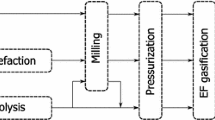Abstract
The cost of transporting wood chips by truck and by pipeline as a water slurry was determined. In a practical application of field delivery by truck of biomass to a pipeline inlet, the pipeline will only be economical at large capacity (>0.5 million dry t/yr for a one-way pipeline, and >1.25 million dry t/yr for a two-way pipeline that returns the carrier fluid to the pipeline inlet), and at medium to long distances (>75 km [one-way] and >470 km [two-way] at a capacity of 2 million dry t/yr). Mixed hardwood and softwood chips in western Canada rise in moisture level from about 50% to 67% when transported in water; the loss in lower heating value (LHV) would preclude the use of water slurry pipelines for direct combustion applications. The same chips, when transported in a heavy gas oil, take up as much as 50% oil by weight and result in a fuel that is >30% oil on mass basis and is about twothirds oil on a thermal basis. Uptake of water by straw during slurry transport is so extreme that it has effectively no LHV. Pipeline-delivered biomass could be used in processes that do not produce contained water as a vapor, such as supercritical water gasification.
Access this chapter
Tax calculation will be finalised at checkout
Purchases are for personal use only
Preview
Unable to display preview. Download preview PDF.
Similar content being viewed by others
References
Kumar, A., Cameron, J. B., and Flynn, P. C. (2003), Biomass Bioenergy 24(6), 445–464.
Cameron, J., Kumar, A., and Flynn, P. C. (2002), in Proceedings of the 12th European Biomass Conference for Energy, Industry and Climate Protection, vol. 1, June 17–21, Amsterdam, The Netherlands, pp. 123–126.
Favreau, J. F. E. (1992), Technical report no. TR-105, Forest Engineering Research Institute of Canada, Canada.
Brebner, A. (1964), Can. J. Chem. Eng. 42, 139–142.
Elliott, D. R. (1960), Pulp Paper Mag. Canada 61, 170–175.
Wasp, E. J., Aude, T. C., Thompson, T. L., and Bailey, C. D. (1967), Tappi 50 (7), 313–318.
Hunt, W.A. (1976), in Proceedings of Hydrotransport 4,1976: 4th International Conference on the Hydraulic Transport of Solids in Pipes, BHRA Fluid Engineering, Cranfield, UK, pp. 1–18.
Liu, H., Noble, J., Zuniga, R., and Wu, J. (1995), Report no. 95–1, Capsule Pipeline Research Center (CPRC), University of Missouri, Columbia.
Jenkins, B. M., Bakker, R. R., and Wei, J.B. (1996), Biomass Bioenergy 10(4), 177–200.
Yoshida, Y., Dowaki, K., Matsumura, Y., Matsuhashi, R., Li, D., Ishitani, H. and Komiyama, H. (2003), Biomass Bioenergy 25(3), 257–272.
Werther, J., Saenger, M., Haetge, E.-U., Ogada, T., and Siagi, Z. (2000), Prog. Energy Combust. Sci. 26, 1–27.
Antal, M. J., Jr., Allen, S. G., Schulman, D. and Xu, X. (2000), Ind. Eng. Chem. Res. 39(11), 819–824.
Matsumura, Y., Xu, X., and Antal, M. J., Jr. (1997), Carbon 35(6), 819–824.
Matsumura, Y., Minowa, T., Xu, X., Nuessle, F. W., Adschiri, T., and Antal, M. J., Jr. (1997), in Developments in Thermochemical Biomass Conversion, Bridgwater A. V. M. and Boocock, D. G. B., eds., Blackie Academic and Professional, London, UK, pp. 864–877.
RS Means Company. (2000), in Heavy Construction Data-14th Annual Edition, Chandler, H. M., et al., eds.
Peters, M. S. and Timmerhaus, K. D. (1991), Plant Design and Economics for Chemical Engineers, 4th Ed., McGraw-Hill, New York, NY.
Author information
Authors and Affiliations
Corresponding author
Editor information
Editors and Affiliations
Rights and permissions
Copyright information
© 2004 Springer Science+Business Media New York
About this paper
Cite this paper
Kumar, A., Cameron, J.B., Flynn, P.C. (2004). Pipeline Transport of Biomass. In: Finkelstein, M., McMillan, J.D., Davison, B.H., Evans, B. (eds) Proceedings of the Twenty-Fifth Symposium on Biotechnology for Fuels and Chemicals Held May 4–7, 2003, in Breckenridge, CO. Biotechnology for Fuels and Chemicals. Humana Press, Totowa, NJ. https://doi.org/10.1007/978-1-59259-837-3_4
Download citation
DOI: https://doi.org/10.1007/978-1-59259-837-3_4
Publisher Name: Humana Press, Totowa, NJ
Print ISBN: 978-1-4684-9873-8
Online ISBN: 978-1-59259-837-3
eBook Packages: Springer Book Archive




